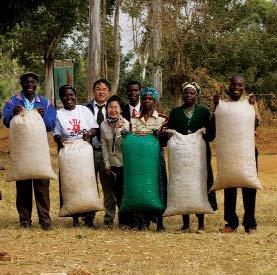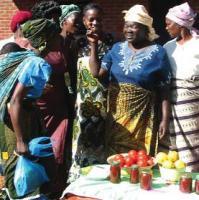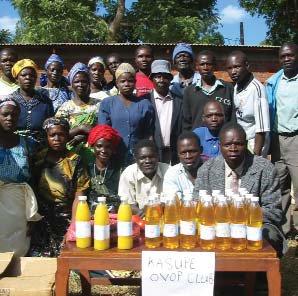One Village One Product
Japan’s rural entrepreneurial scheme goes abroad
By Willhemina Wahlin & Dr Kaoru Natsuda

The One Village One Product (OVOP) scheme is a way of rethinking the possibilities for small, rural populations, introducing ways to re-brand what they do best. Founded in the Kyushu prefecture of Oita over 20 years ago, it’s now being exported to some of the world’s Least Developed Countries (LDCs). Still riddled with challenges, its greatest potential is the entrepreneurial independence it encourages in many of the world’s poorest communities.
Oita prefecture’s experiment
The OVOP scheme began as a way of developing products or services within a community by adding value to locally available resources. It was first introduced as a policy in Japan by former Governor of Oita prefecture, Hiramatsu Morihiko, considered the father of OVOP and the first Governor in Japan’s history to act as a salesman for local producers, at one time even taking beef from the prefecture to the Tokyo meat markets. As legend has it, the middlemen were so impressed by this enthusiastic politician, they paid a higher bidding price for his wares. His enthusiasm for pushing Oita’s products and, less tangibly, festivals and cultural sites, brought the prefecture under the spotlight on many occasions.
 One Village One Product - Malawi (2)
One Village One Product - Malawi (2)
But it is probably in the town of Oyama, also in Oita, that OVOP has its roots. Predating the introduction of OVOP, the head of the town, Harumi Yahata, encouraged the diversification of the town’s agricultural practices, and directed farmers to plant ume (plum) trees and chestnuts. According to Kinjo Gakuin University’s Professor Fumihiko Adachi (an expert in development), Yahata’s plan was all the more risky because it placed the town in direct opposition to the central government ministry at the time, which was enforcing increased rice cultivation.
The fact was that growing rice in Oyama was never going to be a very profitable exercise. A mountainous region, each farmer’s plot was relatively small, leading to consistently low incomes for the farmers. Mr Yahata protested. “Why,” he said in the town meeting of 1961, “should the salarymen of the large cities get bonuses each year and incremental increases in their base salary, while we struggle to survive year to year? Why should we never be able to take a holiday in Hawaii?”
So, with the catchphrase, “Let’s plant plum and chestnut and go to Hawaii,” Oyama began to re-shape its own destiny by choosing its own specialties. While these specializations changed many times over the years, it was the community’s ability to work together to quickly implement those changes that brought about a massive increase in the town’s wealth. In 1967, 16 farmers made it to Hawaii. By 2000, the town was shipping ¥1 billion worth of unprocessed agricultural products, and generating over ¥1.2 billion in proceeds from processed foods and their growing chain of organic food restaurants—not bad for a population of 3,910, 1,063 of which were over 65 in 2000.
Inspired by the success of Oyama, and the later success of the tourist town Yufuin, the OVOP scheme was founded on three main principles: ‘Think globally, Act locally;’ ‘Self-Reliance and Creativity;’ and ‘ Human Resource Development.’
The idea is to create competitive products made from local materials and knowledge, and provide equipment, human resource development and marketing expertise to facilitate the process.
According to the Oita OVOP International Exchange Promotion Committee, over 300 products fell under the auspices of the OVOP scheme, some of which have become famous throughout Japan and other countries. These include Kobosu limes, and Bungo beef, which topped the Japan Beef Grand Championship in 2002. Additionally, Oita’s shiitake mushrooms are some of the best in Japan, accounting for around 28% of Japan’s total yield.
The Ministry of Economy, Trade and Industry (METI), the Japan International Cooperation Agency (JICA) and the Japan External Trade Organization (JETRO), adopted a version of the scheme in the early 2000s, as a way of encouraging development in LDCs. They view OVOP as a strategic way for local people to identify local products and widen their market appeal. So far, the OVOP scheme has been introduced to countries such as Thailand, Cambodia, Bangladesh, Haiti and Malawi.
Case study: Malawi
Malawi is one of the least developed countries in the world. Agriculture is the backbone of Malawi, accounting for 90% of the country’s exports. With 85% of the population living in rural areas, this land-locked country was in desperate need of a scheme such as OVOP when it was introduced in 2003.
Since that time, approximately 46 projects have got off the ground, ranging from dairy products to jams, and breads to oyster mushrooms. OVOP’s National Coordinator in Malawi told the UN’s IRIN news service this year that there are also many challenges to deal with, particularly because the scheme’s application process is severely understaffed. “We have received close to 1,000 proposals from different parts of the country. Some of these proposals are asking us to assist farmers or producers to train them in business management; others are asking for loans to buy food-processing equipment,” she explained. In addition, finding funds for all of the project proposals themselves presents another challenge. The Malawi OVOP Secretariat is trying to establish links with Micro Financing Institutions as one way of solving this problem.
 Exporting Experts: Japanese professionals provide valuable training for Malawians, raising the value of products and the skills of people.
Exporting Experts: Japanese professionals provide valuable training for Malawians, raising the value of products and the skills of people.
Another challenge is accessing wider markets. Around 2,000 farmers in Malawi have taken up rice farming, and crop yields have been high in both quantity and quality. Despite this, the price has remained low because the farmers can only sell it within the domestic market. The OVOP scheme is slowly opening the doors to wider markets for the farmers. Other products, such as honey, are already being exported to neighbouring Mozambique as well as Japan, and despite a drought in 2005, Malawi’s maize crops have been so abundant this year, they have donated 10,000 tonnes of the grain to Lesotho and Swaziland, which are still drought-ravaged.
METI and JETRO have been playing a vital role in promoting Malawi’s products to Japanese consumers and businesses. Between February 2006 and March 2007, OVOP Markets were sponsored by the two organizations at six of Japan’s major airports, with three markets re-opening in March this year. In addition, Expos have become a major marketing vehicle for the products, such as FOODEX Japan, the African Fair and the One Village One Product Fair, giving Malawi’s products some much needed exposure to overseas markets.
Empowering the localities
One of the most important aspects of the OVOP scheme has been in human resource development. In 2005, JICA introduced the Institutional and Human Resources Development Project to Malawi, enabling farmers and producers to gain valuable training in agro-processing, quality control and packaging from Japanese experts. Training in marketing, which was such an important aspect of the original OVOP scheme in Japan, is also enabling LDC communities to create strong branding for their products.
Creating avenues for LDCs to trade fairly and competitively with other nations is one of the most important issues facing these economies, and goes right to the heart of debates surrounding fair trade. In a small, but significant way, Japan’s adaptation of its OVOP scheme is allowing small communities to take control over their own lives, produce and cultures, in much the same way so many rural Japanese have in the past. JI
Dr Kaoru Natsuda is a Political Economist. He has worked as an Official Development Assistance (ODA) consultant for Ernst & Young Shin Nihon in Tokyo, and is currently an Assistant Professor in Development Economics at Ritsumeikan Asia-Pacific University.
Willhemina Wahlin is a Staff Writer with J@pan Inc Magazine.







